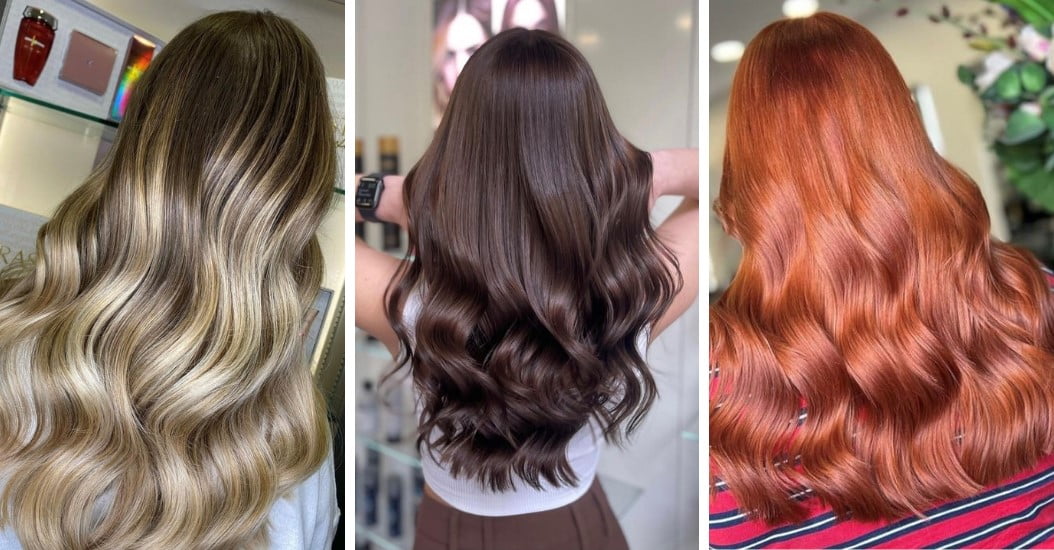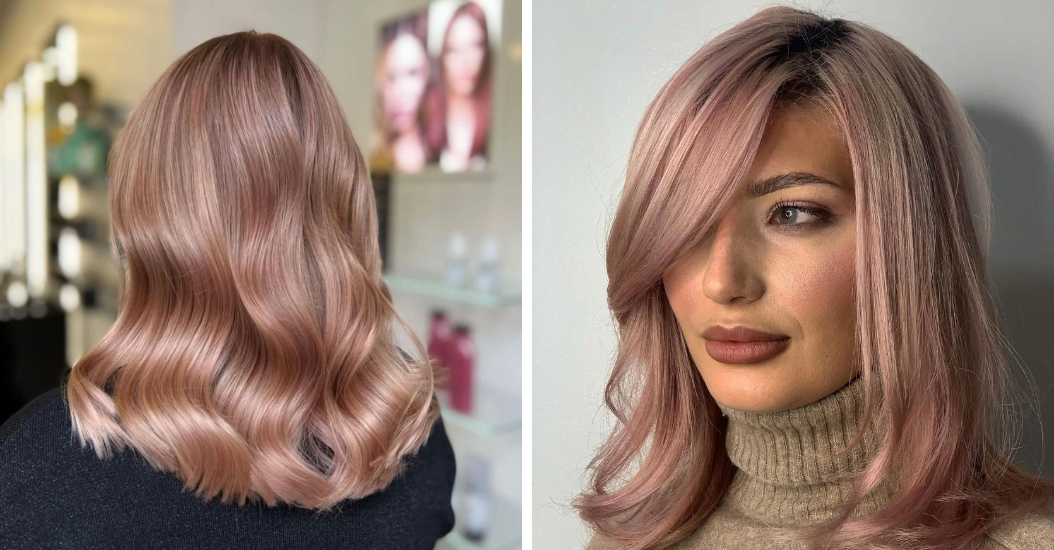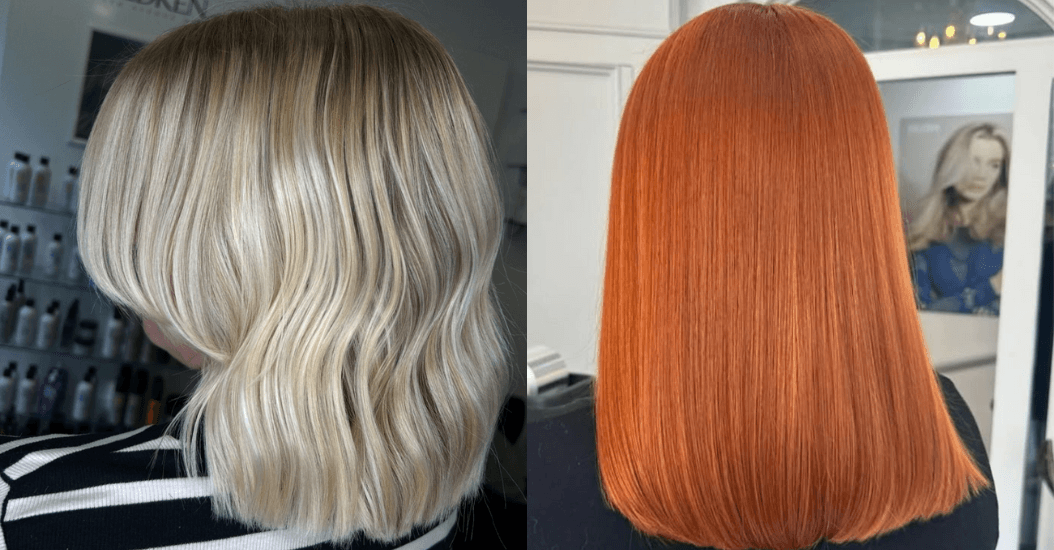At Rush, we believe that embracing your natural hair type is the first step to unlocking the full potential of your locks. Whether you’re dreaming of peachy highlights or a chic long bob, understanding your hair’s unique characteristics is key. Our expert, Sophie Chandler from our Artistic Team & Croydon Stylist, is here to help you navigate the world of hair types.
What are hair types?
Whenever we talk about types of hair, we’re usually referring to your curl pattern and hair thickness. Different follicles produce four broad categories; straight, wavy, curly and coiled, and each of these has three subcategories, forming the 12 different hair types.
Whether it’s poker-straight and fine, or tightly coiled and thick, knowing your natural hair type can give you a better understanding of how to style and care for it.
If you’re trying to work out which category your strands fall into, make sure you wash it first, so it’s completely free of styling products, then examine individual strands closely in the mirror.
Hair Types at a Glance
Your hair type is determined by your curl pattern and hair thickness. Here’s a quick overview to help you identify your hair type:
| Hair Type | Shape |
|---|---|
| Type 1: Straight |
|
| Type 2: Wavy |
|
| Type 3: Curly |
|
| Type 4: Coily |
|
Type 1 – Straight Hair
Straight hair has no curl to it. Natural oils from the scalp tend to move more easily down the length of each strand, which can give straight locks an appealing glow.
However, this can sometimes lead to a greasy look, particularly if your hair is on the finer side. Dry shampoo (rather than over-washing) should help to cleanse oily hair without adding to the problem.
Type 1A – Poker-Straight
1A is the least common hair type; it’s extremely fine and perfectly straight. By its nature, this hair type can look a bit flat and limp and might prove difficult to style.
Explore Type 1A Hair.
View this post on Instagram
Type 1B – Straight with a Little Texture
1B has a bit more volume and body than 1A, with a slight bend toward the end of each strand, which makes it more likely to hold a curl and less likely to appear flat.
Explore Type 1B Hair
View this post on Instagram
Type 1C – Straight with Almost-Waves
Of all the straight hair types, 1C is typically very thick. It has a suggestion of waves without falling into the wavy category, and your strands will be relatively coarse. An attractive, tousled look comes naturally to 1C hair.
Explore Type 1C Hair
View this post on Instagram
Caring for Hair Type 1 (Straight Hair)
- Use a lightweight shampoo and conditioner to avoid weighing down your hair.
- Incorporate dry shampoo into your routine to absorb excess oil between washes.
- Protect your hair from heat damage with a heat protectant spray before using styling tools.
- Consider using a silk or satin pillowcase to reduce friction and prevent breakage.
If you’re considering a colour change, read our article What Hair Colour Suits My Skin Tone to find the perfect shade for your straight hair.
Type 2 – Wavy Hair
Wavy hair, often called ‘mermaid hair,’ should naturally form an ‘S’ shape. In many ways, wavy hair is a happy medium between straight and curly hair, but it isn’t always easy to maintain.
Type 2A – Tousled Hair
2A is a gently wavy hair type with a naturally tousled look. An S-shaped bend might just about be discernible, but it’ll be loosely defined. 2A hair tends to be straight from the roots to eye level, then gently wavy to the tips.
Explore Type 2A Hair
View this post on Instagram
Type 2B – S-Shape Waves
This naturally tousled hair type is similar to 2A but tends to be characterized by a more defined S shape, which can mean it’s harder to straighten. With fine-to-medium thickness, 2B waves won’t need as much encouragement to show off as 2A waves do, with more distinct curls starting around your eyes.
Explore Type 2B Hair
View this post on Instagram
Type 2C – Defined Waves with a Few Curls
2C is thick and often characterized by more tightly defined waves, which almost verge on curls! Starting close to your crown, the waves are mostly still S-shaped, but can have coarser textures mixed in. Like 2B, the 2C hair type is prone to frizz.
Explore Type 2C Hair
View this post on Instagram
Caring for Hair Type 2 (Wavy Hair)
- Choose a sulfate-free shampoo to gently cleanse without stripping natural oils.
- Use a hydrating conditioner to define waves and add moisture.
- Apply a curl-enhancing mousse or cream to damp hair to encourage wave definition.
- Avoid brushing your hair when dry to prevent frizz; instead, use a wide-tooth comb or finger-comb through wet hair.
Type 3 – Curly Hair
The curly hair type is characterized by naturally defined ringlets; these tend to prevent your scalp’s natural oils from spreading down the full length of your strands. What this means is that curly hair is prone to dryness.
Type 3A – Big and Loose Curls
The loosest curly hair type, 3A often features a mix of tight waves alongside loosely formed loops. It’s possible to straighten this hair type, but take care, as it can be prone to heat damage.
Explore Type 3A Hair
View this post on Instagram
Type 3B – Bouncy Ringlets
3B curls are a lot more spiraled than 3A. These ringlets are abundant and springy and tend to start at the roots. 3B hair can be dry, so moisturizing products are a must.
Explore Type 3B Hair
View this post on Instagram
Type 3C – Corkscrew Curls
Made up of tight, springy, corkscrew curls, 3C manes pump up the volume. They’re ultra-thick but are prone to frizz. For this hair type, blow-drys and combing are best avoided; instead, leave-in conditioners and moisturizing oils help fight dryness.
Explore Type 3C Hair
View this post on Instagram
Caring for Hair Type 3 (Curly Hair)
- Use a moisturizing, sulfate-free shampoo to cleanse without drying out your curls.
- Deep condition regularly to maintain hydration and elasticity.
- Apply a leave-in conditioner or curl cream to wet hair to define curls and reduce frizz.
- Avoid using a traditional towel to dry your hair; instead, use a microfiber towel or cotton T-shirt to gently scrunch out excess water.
Type 4 – Coily Hair
Coily hair is coarse and kinky, retaining its shape when wet rather than straightening out into waves. Coily hair doesn’t have the same discernible ringlets that curly hair types have.
Type 4A – Tight Coils
Type 4A hair features dense, tightly coiled curls that are usually around the diameter of a pen. Unlike other coiled hair types, 4A hair falls downwards, like in categories 1, 2, and 3. Softer and finer than 4B or 4C, this hair type tends to be extremely delicate.
Explore Type 4A Hair
View this post on Instagram
Type 4B – Zig-Zag Curls
Characterized by tight zig-zagging kinks. Defined curls can easily become overwhelmed by frizz, and it can take a time-consuming regime to maintain well-defined curls. Again, butters and curling creams can help.
Explore Type 4B Hair
View this post on Instagram
Type 4C – Dense, High-Volume Coils
The tightest category of coiled hair, 4C coils are extremely dense (think 70s afros) and it can be hard to discern any defined curls. This category of hair is quite fragile and hard to untangle, so cautious brushing is advised. Rich conditioners are your friend, so you might decide to ditch shampooing in favor of co-washing.
Explore Type 4C Hair
View this post on Instagram
Caring for Hair Type 4 (Coily Hair)
- Use a creamy, moisturizing shampoo to cleanse without stripping natural oils.
- Deep condition with a rich, nourishing conditioner to maintain moisture.
- Apply a leave-in conditioner or oil to seal in moisture and add shine.
- Protect your hair with regular deep conditioning treatments and by wearing protective styles like twists or braids.
If you’re thinking about adding highlights to your coils, learn about the subtle beauty of Babylights Vs Highlights to enhance your natural texture.
General Hair Care Tips for All Hair Types
- Regular Trims: Keep your ends healthy and prevent split ends by getting regular trims every 6-8 weeks.
- Gentle Washing: Use a sulfate-free shampoo to cleanse your hair without stripping it of natural oils.
- Deep Conditioning: Treat your hair to a deep conditioning treatment or hair mask at least once a week to maintain moisture and strength.
- Heat Protection: Always use a heat protectant spray before using heat styling tools to minimize damage.
- Healthy Diet: A balanced diet rich in vitamins and minerals can support healthy hair growth.
Summary
Understanding your hair type is essential for choosing the right care routines and styles. Whether you have straight, wavy, curly, or coily hair, there are specific tips and products to help you maintain its health and beauty. Embrace your natural hair type and experiment with styles that complement it.
Visit Rush Hairdressers for Personalised Care
Ready to embrace your unique hair type? Visit one of our hair salons or book an appointment for personalised advice and styling to enhance your natural beauty. Our stylists are here to help you achieve the perfect look for your hair type.
FAQs
Q: How can I determine my hair type?
A: The four main hair types are Type 1 (straight), Type 2 (wavy), Type 3 (curly), and Type 4 (coily).
Q: Can my hair type change over time?
A: Yes, factors like age, hormones, and chemical treatments can alter your hair type.
Q: How often should I wash my hair?
A: This depends on your hair type. Straight hair may need more frequent washing, while curly and coily types can go longer between washes.
Q: Are there specific products for each hair type?
A: Yes, there are products formulated to address the needs of different hair types, from moisturizing curly hair to volumizing fine, straight hair.
Q: Can I change my hair type?
A: While you can’t change your natural hair type, you can alter its appearance with styling tools and treatments.
Q: What’s the best hair type?
A: There is no “best” hair type. Each hair type has its unique beauty and characteristics. Embrace and care for your natural hair type.
Q: What’s the difference between 1b and 2a hair types?
A: Type 1b hair is straight with a little texture and body, while Type 2a hair is wavy with a gentle S-shaped pattern.
Q: What’s the rarest hair type?
A: Type 1a (poker-straight, fine hair) is considered one of the rarest hair types due to its very fine texture and lack of volume.
Q: How can I tell if my hair is 2b or 2c?
A: Type 2b hair has more defined S-shaped waves, while Type 2c hair has well-defined waves with a thicker, coarser texture.
Q: Is it possible to have a combination of hair types?
A: Yes, it’s common to have a combination of hair types, such as having Type 3a curls with some 3b ringlets mixed in.








